Building Your Agile Transformation Roadmap

Agile transformation means adopting and integrating Agile principles across an entire organization. The approach helps enhance adaptability and responsiveness within teams. The ultimate goal? To deliver services, products, and value to clients swiftly.
Many organizations are turning to Agile transformation as their north star. But guiding this change is no small task. That is where an Agile transformation roadmap comes in. It outlines the fundamental steps required for a smooth transition.
This guide will illuminate the strategic steps necessary for leaders, thinkers, and visionaries like you.
What is Agile Transformation
Agile transformation embodies a shift from traditional management practices to a more dynamic, collaborative, and customer-focused approach. At its core, it promotes flexibility and responsiveness, dismantling hierarchical decision-making structures. Agile transformation empowers teams to self-organize, fostering an environment where client value delivery becomes the norm.
McKinsey and Company highlights that a successful Agile transformation impacts four primary aspects of an organization: people, processes, technology, and structure.
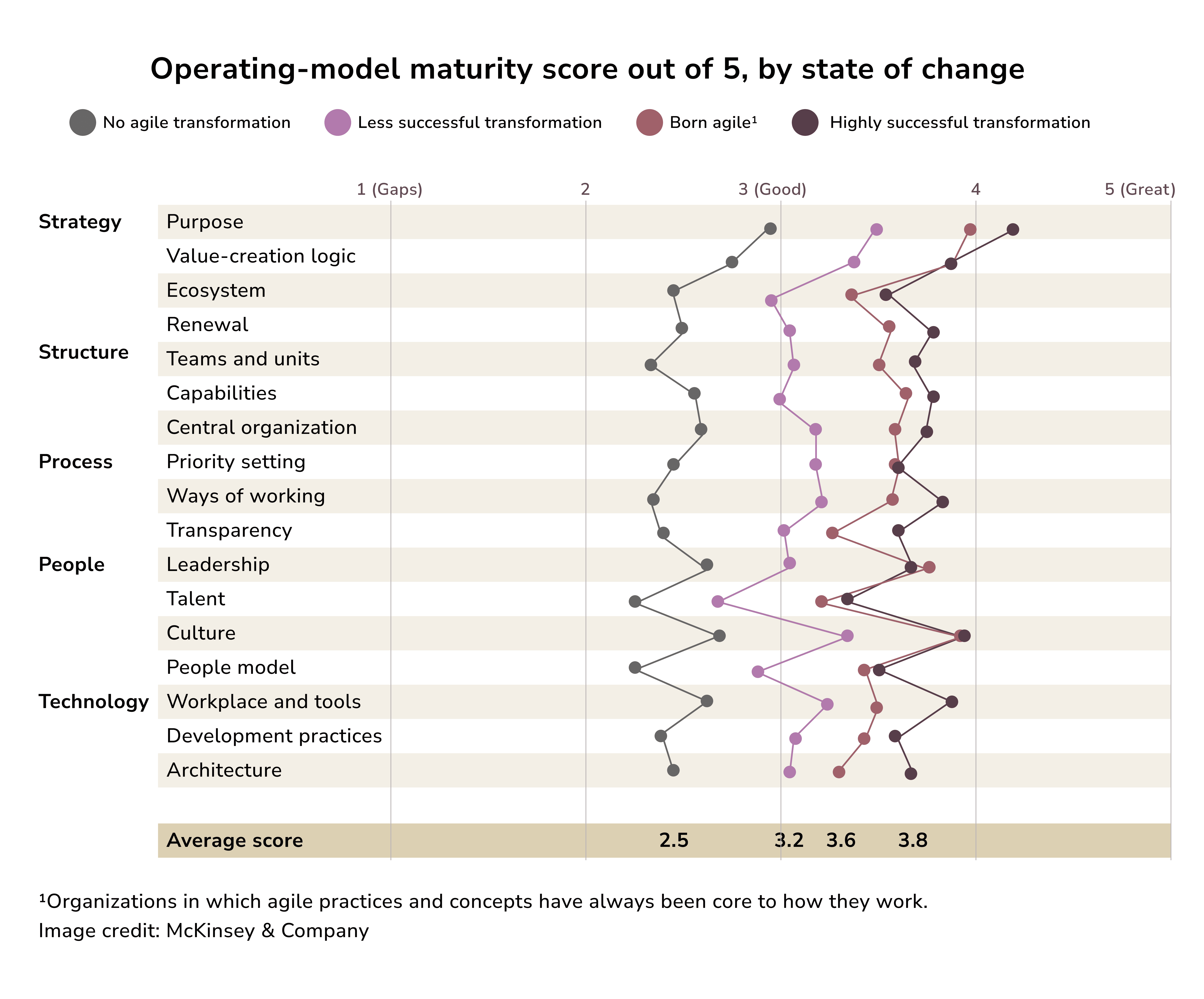
To shift smoothly, companies have to implement an iterative strategy. This implies cyclically repeated tasks until the most effective outcome is reached.
Here are the key steps of an agile transformation process:
- Changing perspectives. Shifting from traditional, hierarchical, and heavily process-oriented approaches. Incorporating a more flexible, team-centric, and value-focused method.
- Building autonomous teams. Forming self-managing, cross-functional teams that possess the authority and responsibility for decision-making.
- Engaging directly with the market. Prioritizing direct engagement with the market and customers. Applying a continuous feedback loop and collaboration with users.
- Implementing iterative and incremental processes. Avoiding large, inflexible plans.
- Fostering continuous improvement. Seeking opportunities to boost efficiency, effectiveness, and overall team dynamics.
- Securing organizational alignment and support. Aligning organizational structures and policies with Agile values. Ensuring access to necessary resources and training.
- Emphasizing delivering customer value above all else. Making client needs a priority.
The ultimate goal? To make organizations adaptive amid changing, uncertain environments.
Agile Transformation vs. Agile Adoption
Agile transformation and Agile adoption are often misinterpreted. Agile adoption means implementing Agile methodologies like Scrum or Kanban. It serves as a short-term solution tailored for specific projects. Since it involves minimal structural changes, it requires less extensive planning.
Conversely, enterprise agile transformation is a far-reaching and enduring process. It’s a gradual implementation of change, potentially spanning several years. The process impacts the entire organization, from the leadership down to the engineering teams. That is why it necessitates a thorough understanding of Agile principles.
Note: Most of the large corporations today lack agility. In 2022, Deloitte surveyed over 10,000 top executives. The result states that fewer than 10% consider their organization "highly agile". Interestingly, more than 90% of leaders acknowledge that "agility and collaboration" are paramount for their firm's success.
The Three Laws of Agile
Agile principles are grounded in three fundamental laws. These are the Law of the Small Team, the Law of the Customer, and the Law of the Network. Together, these guide the foundation of an Agile organization. They help us comprehend the diverse Agile practices, which may vary depending on the context. While practices may evolve, the mindset encapsulated by these three core principles remains a constant guide for organizations adopting Agile methodologies.
- The Law of the Small Team suggests that work should preferably be conducted by small teams within short cycles. This principle is widely recognized in the Agile community. It also aligns with the early focuses of Agile software developers.
- The Law of the Network commands organizations to break away from static models. Agile practitioners view firms as transparent, fluid networks, where collaboration thrives. The focus shifts from rigid control to fostering flexibility and customer-centric innovation.
- The Law of the Customer is the lynchpin of Agile. It asserts that the core purpose of a business is to deliver value to the customer. The concept is the synergy of these three elements. When unified and directed toward a shared external goal, it unleashes a tremendous surge in value.
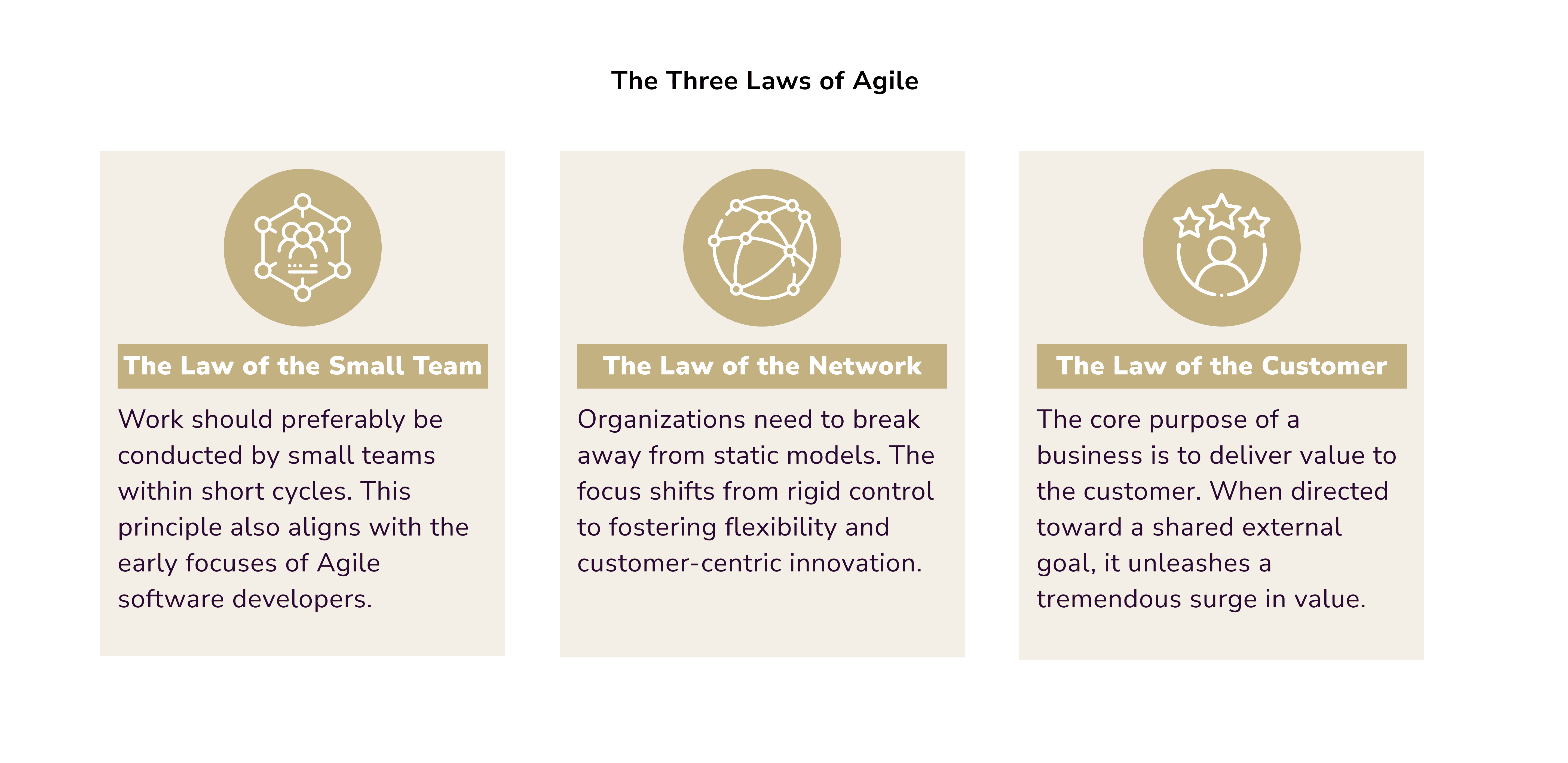
Agile Transformation Roadmap
The Agile transformation roadmap is a strategic blueprint for a successful transition. It outlines the steps your organization has to take to reach agility.
Keep in mind that implementing an Agile transformation isn't a one-time effort; it's an ongoing journey. Regularly assess your progress and be willing to adjust your strategy if necessary.
Take the first step toward transformation by following the steps below.
Adopting the Agile Mindset
The Agile mindset is characterized by openness to change, a focus on collaboration, and a dedication to delivering customer value. It's rooted in the principles outlined in the Agile Manifesto.
To cultivate an Agile mindset, leaders should reimagine their roles. They should focus on empowering their teams, trusting them to make decisions and innovate. Encourage experimentation and view failures as opportunities for learning and growth.
This mindset shift promotes a culture where team members feel valued and motivated to contribute their best.
Evolving Gradually for a Sustainable Change
Agile transformation isn't a quick fix; it's a gradual evolution happening according to a careful plan. Attempting to overhaul your entire org overnight can lead to resistance and burnout. Start small, implement changes in manageable increments, and build momentum over time.
Throughout this process, prioritize transparency and celebrate wins, even the smallest ones. Convey the benefits Agile transformation brings throughout the organization as a whole. By highlighting teams’ successes, you create a positive momentum. That is what encourages the broader adoption of Agile principles.
Keeping Leadership in the Loop
This one is extremely important. A lack of leadership involvement and inadequate Agile knowledge remain significant barriers to adopting an Agile framework in 2022, according to the 16th State of Agile Report.
Business Agility Institute indicates a strong correlation between leadership involvement and advancements in agility. Essentially, progress in adopting agile practices is more pronounced with higher-level supervision. Leadership is about guidance. Their insights should inspire as they actively champion the transition. They have to commit across all levels to embedding Agile values into the organization's DNA.
Turning Vision into Tangible Objectives
A clear vision guides your organization toward a shared future. However, a vision alone isn't enough; it must be translated into actionable objectives that drive tangible outcomes. These objectives should be SMART—specific, measurable, achievable, relevant, and time-bound.
Every objective should have an owner who is accountable for its achievement. This fosters ownership and accountability, motivating teams to take proactive steps toward realizing the vision. Celebrate milestones along the way to acknowledge progress and encourage continued effort.
Selecting a Pilot Team for a Test-Run
Choosing the right pilot team is crucial. Ideally, the team should be cross-functional, possessing diverse skills to adapt to new methodologies. Start with a group open to change, willing to experiment, and capable of setting a positive precedent for the organization.
Provide your pilot team with the resources and support needed to experiment with Agile practices. Celebrate their successes and learn from any stumbles. Their experience will guide the broader rollout and ensure smoother implementation across other teams.
Cascading the Agile Culture Across Your Company
Transforming a large organization requires dedication, urgency, enthusiasm, and the energy to inspire others. All while maintaining a realistic perspective on the magnitude of the task and the time it will require. The transformation can span over a decade. For instance, Microsoft embarked on its Agile transformation in 2008 and continues on this path today.
The Lean Change Method in Agile Digital Transformation
The Lean Change Method, a strategic approach to Agile transformation, fuses concepts from Lean Startup, Agile, Organizational Development, and Change Management. It is designed to be dynamic and adaptable, embracing the unpredictability inherent in organizational change.
Here are the essential components of the Lean Change Method:
- Gathering insights into the organization's current state. This involves analyzing the existing culture, processes, and challenges.
- Developing a variety of potential solutions. These solutions are framed as hypotheses ready for testing.
- Experimentation. Every hypothesis translates into a small, low-risk experiment. The goal is to test assumptions and gather data on their viability.
- Continuous feedback. This helps determine what is effective and what isn't within each org's unique context.
- Iterating on its methods. Successful experiments can be expanded and integrated more broadly. Discard or adjust the ones that fail.
- Embracing an ongoing change, not a one-time initiative. Maintain readiness to react to evolving market demands.
- Focusing on people. Navigate transition through collaboration and transparent communication. This especially concerns those impacted by the change.
- Aligning transformation with the organization's overarching purposes. Make sure your efforts contribute to long-term organizational objectives.
Why go Agile?
Transitioning to Agile helps businesses remain competitive. It enables fast response to market changes, fostering innovation, and improving efficiency. Agile empowers teams via collaboration and flexibility, ultimately enhancing the value delivered to customers.
A study by McKinsey and Company involving over 2,000 global participants revealed that organizations implementing successful agile transformations see up to 30% improvement in areas such as employee engagement, operational efficiency, and customer satisfaction. Additionally, teams adopting agile methodologies achieve delivery speeds 5-10 times faster. This helps them maintain or outpace competitive benchmarks.
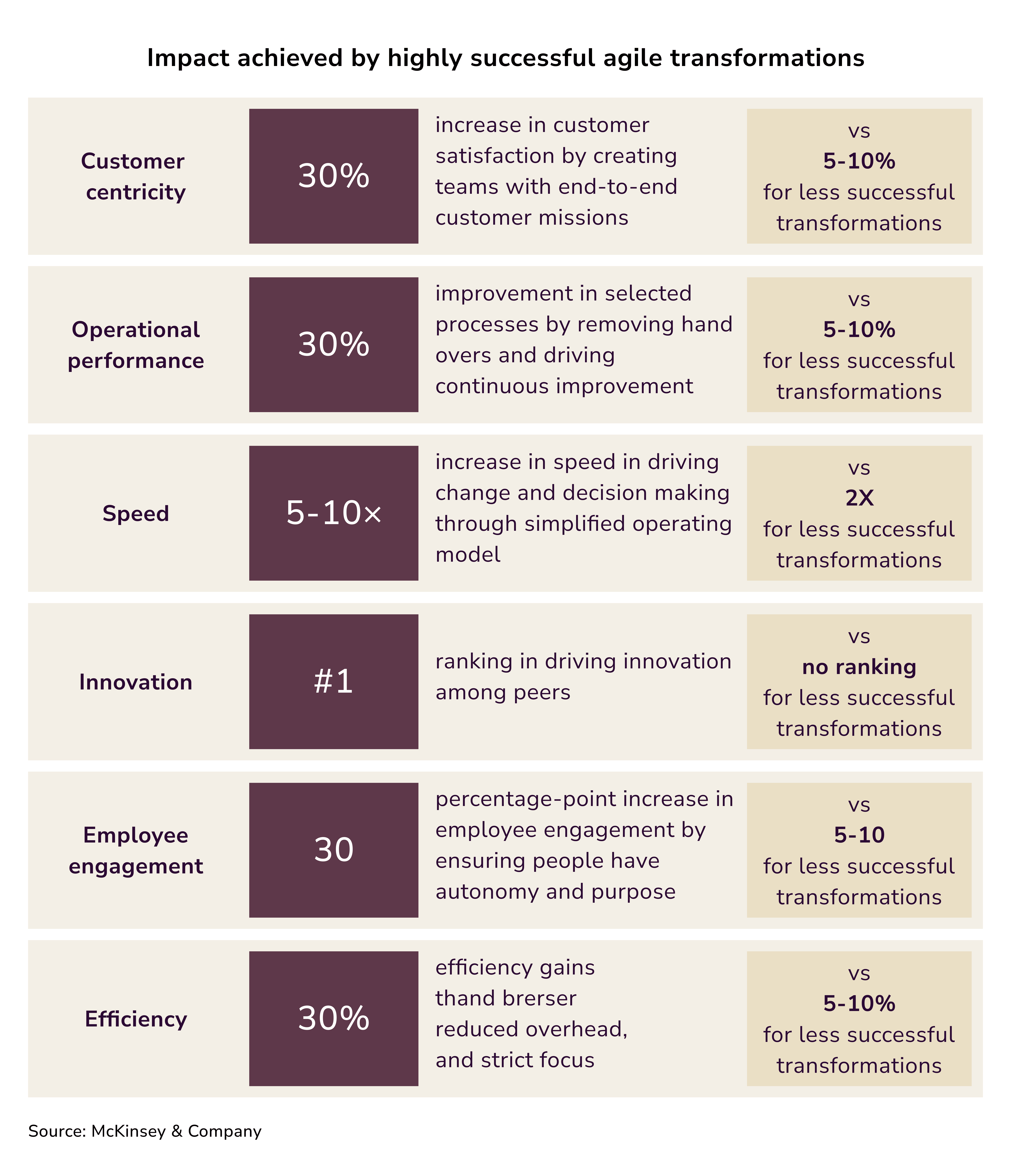
Simply put, a well-executed agile transformation can help businesses rank among the top players.
Here are the reasons why companies choose to adopt agile practices:
- to enhance business agility and resilience
- to pivot strategies when new opportunities emerge
- to stay ahead of the competition
- to build long-lasting relationships with customers
- to increase teams’ motivation and commitment.
Here's a comparison of traditional vs. Agile practices that better visualize the latter's benefits.
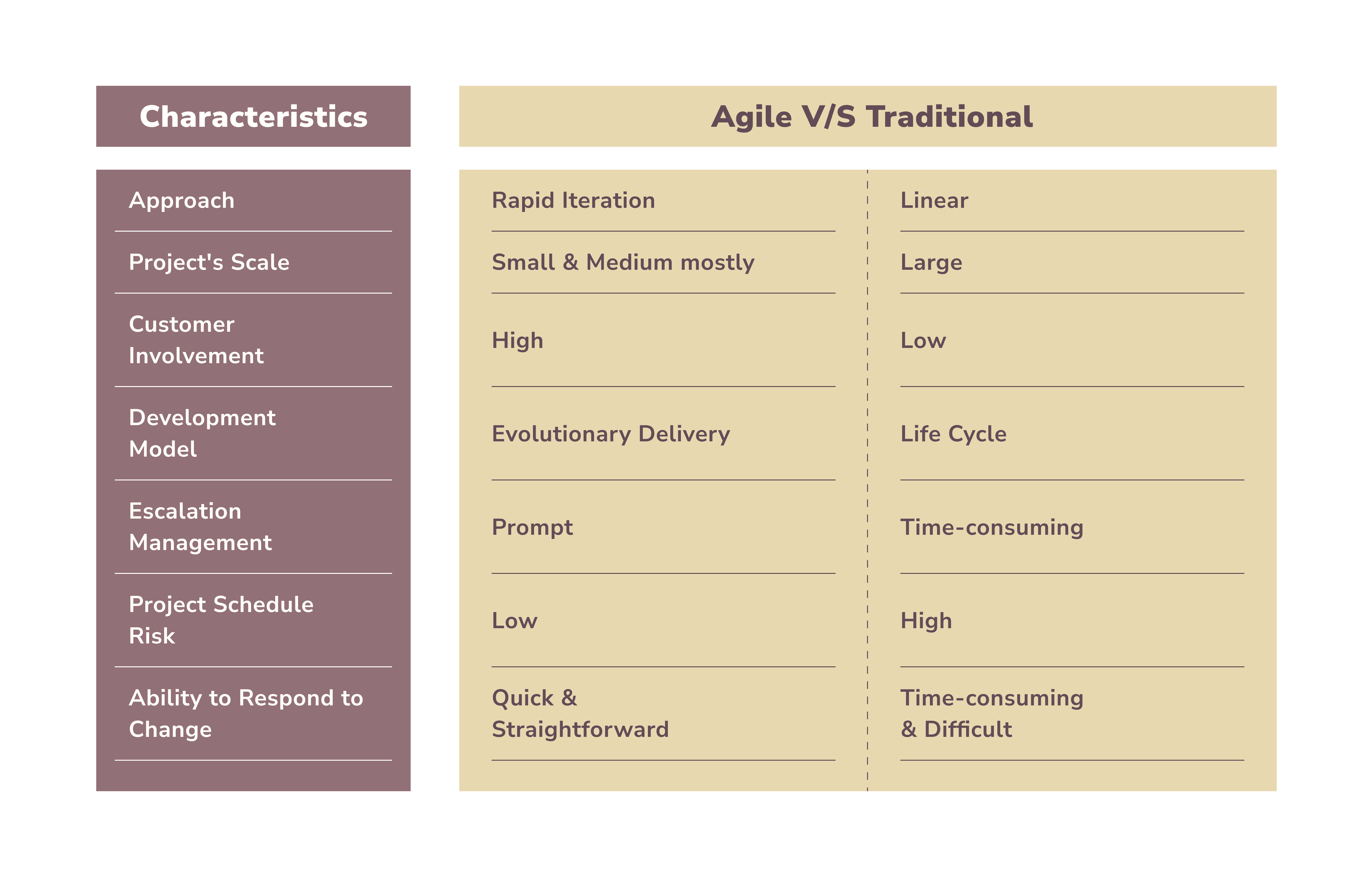
Benefits of Agile Methodology
Agile methodologies streamline workflows, increase productivity, speed up time-to-market, and increase team morale. Agile allows for quick pivots, ensuring customer satisfaction. It helps businesses improve risk management and focus on delivering customer-focused solutions.
Here are the top advantages of agile methodologies:
- Agile methodology drives innovation. Experimentation and iteration create a culture where ideas are valued. The iterative cycle fuels creativity, leading to breakthrough solutions.
- Agile methodology breaks down silos, so businesses can leverage diverse expertise to achieve common goals.
- Agile methodology emphasizes iteration and adjustment. This flexibility ensures that companies can remain relevant in dynamic markets.
Note: as it turns out, orgs that adopted Agile before the COVID-19 crisis outperformed those that didn't.
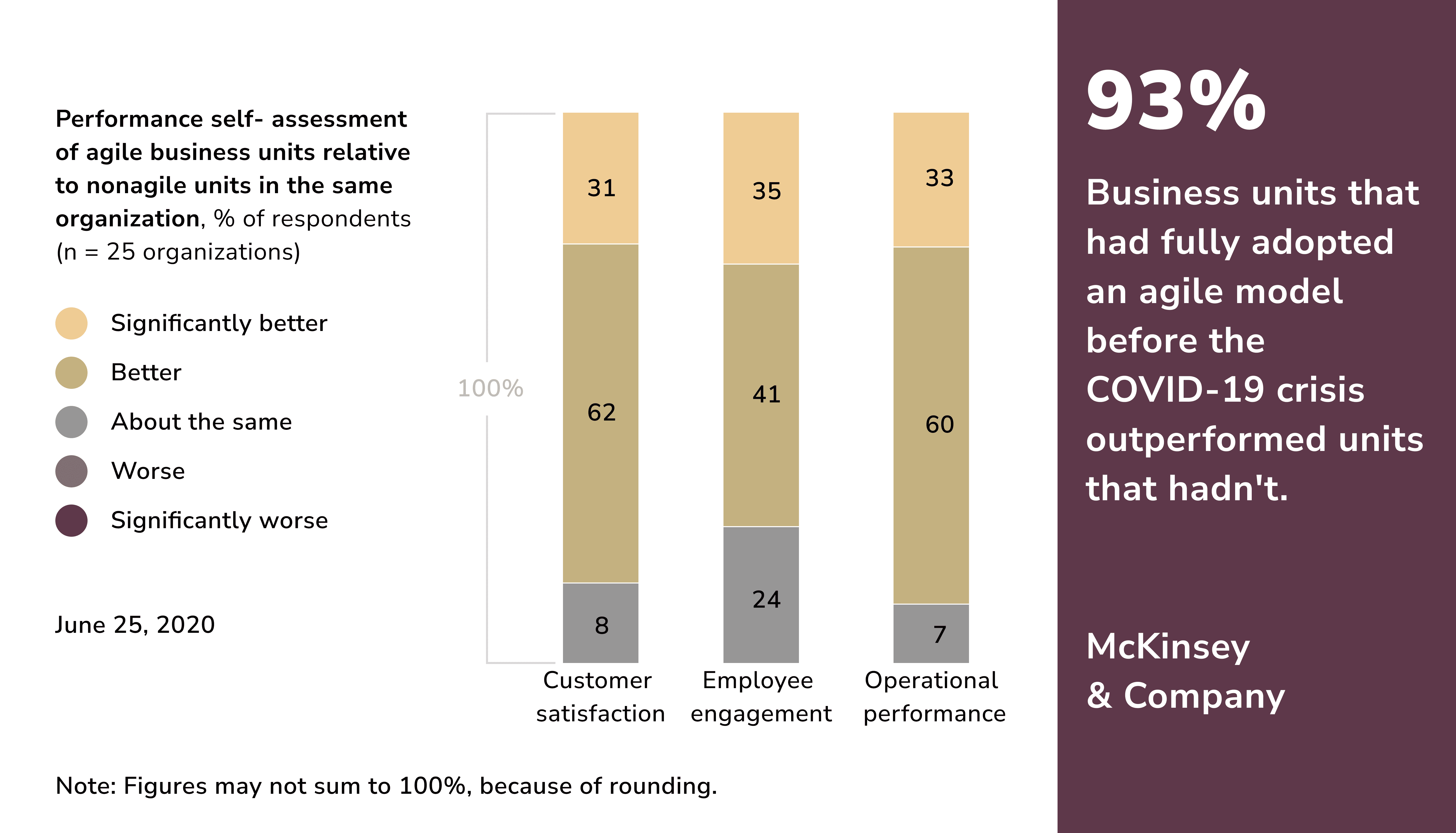
Benefits of Agile Roadmap
An Agile roadmap provides structure and direction toward agility. It outlines clear insights into progress and potential stumbling blocks. An Agile roadmap acts as a communication tool to align teams and stakeholders toward shared goals. All while maintaining flexibility to adapt as priorities evolve.
Here are the top advantages of the Agile roadmap:
- It guides your transformation with a clear structure and direction. By mapping out the steps needed to achieve your objectives, you create a clear path to success.
- Agile roadmaps provide a visual representation of your transformation strategy. It evolves as your business adapts to new challenges and opportunities.
- Roadmaps also promote accountability by assigning roles/milestones. This accountability motivates teams to take proactive steps to reach their goals.
Agile Transformation Roadmap Template
An Agile transformation roadmap template outlines the actions necessary to advance the shift. It includes stakeholder priorities, projected iterations, and metrics for progress evaluation. It’s essential for planning, communication, and gathering insights for product success.
Here are the core components of an agile transformation roadmap template:
- Phases: planning, pilot execution, process setup, sprint execution, scaling, and ongoing improvement.
- Timeline: short-term objectives and long-term goals (leave a place for the evolution of the transformation).
- Tasks: establishing Agile teams, conducting training sessions, launching pilot projects, and evaluating outcomes.
- Stakeholders/Teams: stakeholders may focus on strategic decisions. The team’s responsibility is to deploy daily Agile practices.
- Streams: each stream manages specific initiatives, like technological upgrades, team restructuring, or refining processes.
- Milestones: checkpoints marking progress within the Agile transformation. Examples include:
- completing a pilot project
- expanding Agile methodologies to additional teams
- reaching performance benchmarks, etc.
- Supporting Documents: examples include:
- a statement of goals depicting the vision for Agile adoption
- an Agile training framework for staff
- a charter for pilot projects detailing the scope of Agile initiatives.
Challenges and Solutions of Agile Organizations
Common Agile organizations' challenges include resistance to change, skill gaps, and communication issues. Overcoming these requires fostering buy-in through training. Offer your team continuous learning opportunities. Invest in tools that enhance cross-team communication and collaboration.
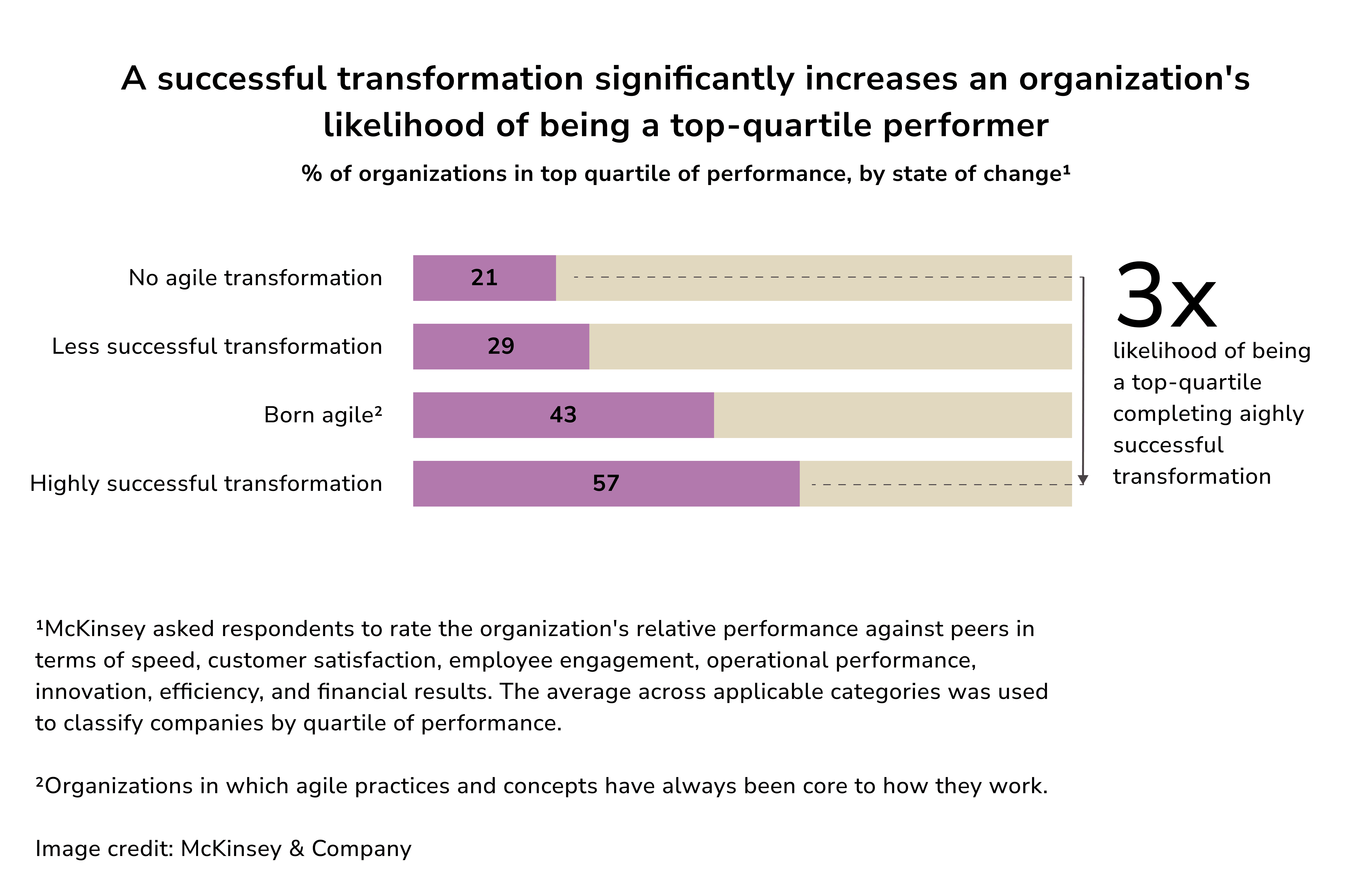
Since the Agile Manifesto was introduced in 2001, convincing managers to adopt Agile practices was a major challenge. However, things have shifted, and now Agile is viewed as a priority by over 90% of top executives. This growing enthusiasm carries the risk of Agile being oversimplified into merely a tool for cutting costs. The success of Agile in many organizations has inadvertently led to the spread of what some call "fake Agile."
Note: when utilized merely for cutting expenses, Agile loses its sense. Some companies apply Agile with their leading teams but neglect its principles in other areas. This maintains grueling work environments that contradict Agile's core values.
Poor management of an initiative can lead to significant repercussions. The most common of them is burnout among staff. Businesses risk losing key talent and increasing tension between teams. Harvard Business Review surveyed 112 companies in 2021. The research revealed that nearly 90% encountered challenges when attempting to implement agile transformations organization-wide.
Focus on Value, not Competition
For most organizations, even successful ones, strategic agility is the next step in evolving their business approach. Yes, operational agility is essential for staying afloat and enhancing current products for existing customers. But it’s no longer enough in competitive markets. Rivals quickly replicate changes, and customer demands dominate.
True growth lies in creating innovations that open new markets. These "market-creating innovations" lead to untapped opportunities, or "blue oceans," as described in Blue Ocean Strategy (2015). Blue oceans are spaces where organizations can deliver unique value to customers. They achieve significant growth and profits without the intense competition of crowded, saturated markets, nicknamed "red oceans."
To step into these blue oceans, businesses need a different approach to innovation. An approach that focuses on creating entirely new value rather than competing within existing spaces.
Your journey to agility doesn't end with transformation; it's a continuous evolution. Stay informed, adapt to changing trends, and remain committed to Agile values. By doing so, your org will remain resilient, ready to seize new opportunities in a complex business world.

Andriy Lekh
Other articles